An Investigation of the Ground Walnut Shells’ Addition Effect on the Properties of the Fly Ash-Based Geopolymer
Abstract
:1. Introduction
2. Materials and Methods
2.1. Materials
2.2. Preparation of Specimens
2.3. Methods
3. Results and Discussion
3.1. Efflorescences
3.2. Water Absorption
3.3. Density and Morphology
3.4. Compressive and Flexural Strength
3.5. Thermal Conductivity
4. Conclusions
- The waste in the form of ground walnut shells with success can be used as a substitute for quartz sand in the production of geopolymer mortars;
- The use of ground walnut shell additive contributes to the increase in absorption properties of fly ash-based geopolymers; with the absorption being higher, the higher the proportion of the additive in the composite;
- The addition of ground walnut shells into geopolymers allows for a very large reduction in efflorescence on their surface, which should be considered a positive effect because, as is known, the appearance of efflorescence in the case of geopolymers can negatively affect their mechanical properties;
- The occurrence of efflorescence may have been caused mainly by the use of low reactive fly ash. Part of the Na present in the alkaline solution (even a small part) was not completely combined with the fly ash and was, therefore, free to react with the CO2 present in the atmosphere;
- The density of geopolymer composites based on fly ash is significantly reduced by the introduction of ground walnut shells in place of sand, allowing for a reduction in its value by almost half with the complete replacement of sand with ground walnut shells;
- Compressive strength and flexural strength are reduced by using ground walnut shells. The reduction in mechanical properties was greater with the higher weight proportion in the mixture used to make the geopolymer composites.
- Partial or complete replacement of sand by ground walnut shells in geopolymer composites based on fly ash allows for a significant reduction in their thermal conductivity (over 50% compared to the reference sample), which makes it possible to use these composites as insulation materials.
Author Contributions
Funding
Institutional Review Board Statement
Informed Consent Statement
Data Availability Statement
Conflicts of Interest
References
- Mugahed Amran, Y.H.; Alyousef, R.; Alabduljabbar, H.; El-Zeadani, M. Clean production and properties of geopolymer concrete: A review. J. Clean. Prod. 2020, 251, 119679. [Google Scholar] [CrossRef]
- Nie, Q.; Hu, W.; Huang, B.; Shu, X.; He, Q. Synergistic utilization of red mud for flue-gas desulfurization and fly ash-based geopolymer preparation. J. Hazard. Mater. 2019, 369, 503–511. [Google Scholar] [CrossRef] [PubMed]
- Ma, C.; Zhao, B.; Guo, S.; Long, G.; Xie, Y. Properties and characterization of green one-part geopolymer activated by composite activators. J. Clean. Prod. 2019, 220, 188–199. [Google Scholar] [CrossRef]
- Hu, W.; Nie, Q.; Huang, B.; Shu, X.; He, Q. Mechanical and microstructural characterization of geopolymers derived from red mud and fly ashes. J. Clean. Prod. 2018, 186, 799–806. [Google Scholar] [CrossRef]
- Wu, Y.; Lu, B.; Bai, T.; Wang, H.; Du, F.; Zhang, Y.; Cai, L.; Jiang, C.; Wang, W. Geopolymer, green alkali activated cementitious material: Synthesis, applications and challenges. Constr. Build. Mater. 2019, 224, 930–949. [Google Scholar] [CrossRef]
- Kozub, B.; Bazan, P.; Gailitis, R.; Korniejenko, K.; Mierzwiński, D. Foamed Geopolymer Composites with the Addition of Glass Wool Waste. Materials 2021, 14, 4978. [Google Scholar] [CrossRef]
- PN-EN 450-1:2012; Popiół Lotny do Betonu—Część 1: Definicje, Specyfikacje i Kryteria Zgodności. Polish Committee for Standardization: Warsaw, Poland, 2014. (In Polish)
- Bastian, S. Betony Konstrukcyjne z Popiołem Lotnym; Arkady: Warsa, Poland, 1980. [Google Scholar]
- Pachowski, J. Rozwój technologii powstawania ubocznych produktów elektrownianych oraz ich charakterystyka i możliwości zastosowań w technologiach budownictwa drogowego. Drog. Most. 2002, 1, 59–99. [Google Scholar]
- Tkaczewska, E.; Małolepszy, J. Właściwości szkła w krzemionkowych popiołach lotnych. Cement-Wapno-Beton 2009, 3, 148–153. [Google Scholar]
- Provis, J.L.; Van Deventer, J.S.J. Geopolymers: Structure, Processing, Properties and Industrial Applications; Woodhead Publishing Limited: Cambridge, UK, 2009. [Google Scholar]
- Liu, J.; Lv, C. Durability of Cellulosic-Fiber-Reinforced Geopolymers: A Review. Molecules 2022, 27, 796. [Google Scholar] [CrossRef]
- Rashad, A.M. The effect of polypropylene, polyvinyl-alcohol, carbon and glass fibres on geopolymers properties. Mater. Sci. Technol. 2019, 35, 127–146. [Google Scholar] [CrossRef]
- Manfaluthy, M.L.; Ekaputri, J.J. The application of PVA fiber to improve the mechanical properties of geopolymer concrete. MATEC Web Conf. 2017, 138, 1020. [Google Scholar] [CrossRef] [Green Version]
- Annalisa, N.; Valentina, M.; Elena, L. Production and thermomechanical characterization of wool-geopolymer composites. J. Am. Ceram. Soc. 2017, 100, 2822–2831. [Google Scholar]
- Mikuła, J.; Łach, M. Geopolymers—A new environment friendly alternative to concrete based on portland cement. Part 1—Introduction. In Pro-Ecological Solutions in the Field of Production. Modern Environmentally Friendly Composite Materials; Mikuła, J., Ed.; Cracow University of Technology: Cracow, Poland, 2007; Volume 1, pp. 13–179. [Google Scholar]
- Silva, F.J.; Thaumaturgo, C. Fibre reinforcement and fracture response in geopolymeric mortars. Fatigue Fract. Eng. Mater. Struct. 2003, 26, 167–172. [Google Scholar] [CrossRef]
- Mohanty, A.K.; Misra, M.; Drzal, L.T. Natural Fibres, Biopolymers, and Biocomposites; Taylor and Francis: Boca Raton, FL, USA, 2005; p. 55. [Google Scholar]
- Alomayri, T.; Low, I.M. Synthesis and characterization of mechanical properties in cotton fiber-reinforced geopolymer composites. J. Asian Ceram. Soc. 2013, 1, 30–34. [Google Scholar] [CrossRef] [Green Version]
- Waghmare, P.M.; Bedmutha, P.G.; Sollapur, S.B. Review on Mechanical Properties of Banana Fiber Biocomposite. Int. J. Res. Appl. Sci. Eng. Technol. 2017, 5, 847–850. [Google Scholar] [CrossRef]
- Procotex SA Corporation, N.V. Technical Date Sheet of Sizal. Available online: https://en.procotex.com/products/natural-recycled-fibres.php (accessed on 1 May 2022).
- Kemenny Vek. Technical Date Sheet of Basalt Fiber. Available online: https://basfiber.com (accessed on 1 May 2022).
- High, C.; Seliem, H.M.; El-Safty, A.; Rizkalla, S.H. Use of basalt fibers for concrete structures. Constr. Build. Mater. 2015, 96, 37–46. [Google Scholar] [CrossRef]
- Nycon. Technical Date Sheet of Polypropylene Fibers. Available online: https://nycon.com/collections/polypropylene-fibers/ (accessed on 1 December 2020).
- Zych, T.; Krasodomski, W. Polyolefin fibres used in cementitious composites—Manufacturing, properties and application. Tech. Trans. Civil Eng. 2016, 113, 155–178. [Google Scholar]
- Bazan, P.; Kozub, B.; Łach, M.; Korniejenko, K. Evaluation of Hybrid Melamine and Steel Fiber Reinforced Geopolymers Composites. Materials 2020, 13, 5548. [Google Scholar] [CrossRef]
- Nycon. Technical Date Sheet of Glass Fibers. Available online: https://nycon.com/collections/fiberglass-fibers/ (accessed on 1 May 2022).
- Payakaniti, P.; Pinitsoonthorn, S.; Thongbai, P.; Amornkitbamrung, V.; Chindaprasirt, P. Effects of carbon fiber on mechanical and electrical properties of fly ash geopolymer composite. Mater. Today 2018, 5, 14017–14025. [Google Scholar] [CrossRef]
- Sarmin, S.N.; Salim, N.; Azura Mohammad, N. Effects of different wood aggregates on the compressive strength of fly ash and metakaolin-based geopolymer lightweight composites. Songklanakarin J. Sci. Technol. 2019, 41, 734–741. [Google Scholar]
- Alomayri, T.; Shaikh, F.U.; Low, I.M. Characterisation of cotton fibre-reinforced geopolymer composites. Compos. Part B Eng. 2013, 50, 1–6. [Google Scholar] [CrossRef] [Green Version]
- Pacheco-Torgal, S.J. Cementitious building materials reinforced with vegetable fibers: A review. Constr. Build. Mater. 2011, 25, 575–582. [Google Scholar] [CrossRef] [Green Version]
- Korniejenko, K.; Frączek, E.; Pytlak, E.; Adamski, M. Mechanical properties of geopolymer composites reinforced with natural fibers. Procedia Eng. 2016, 151, 388–393. [Google Scholar] [CrossRef]
- Alomayri, T.; Shaikh, F.U.A.; Low, I.M. Thermal and mechanical properties of cotton fabric-reinforced geopolymer composites. J. Mater. Sci. 2013, 48, 6746–6752. [Google Scholar] [CrossRef]
- Pech Pehanich, J.L.; Blankenhorn, P.R.; Silsbee, M.R. Wood fiber surface treatment level effects on selected mechanical properties of wood fiber–cement composites. Cem. Concr. Res. 2004, 34, 59–65. [Google Scholar] [CrossRef]
- Hakamy, A.; Shaikh, F.U.; Low, I.M. Characteristics of hemp fabric reinforced nanoclay–cement nanocomposites. Cem. Concr. Compos. 2014, 50, 27–35. [Google Scholar] [CrossRef]
- Sima Simatupang, M.H.; Geimer, R.L. Inorganic binder for wood composites: Feasibility and limitations. In Proceedings of the Wood Adhesive: Symposium Sponsored by USDA Forest Service, Forest Products Laboratory and the Forest Products Research Society, Madison, WI, USA, 16–18 May 1990; pp. 169–176. [Google Scholar]
- The International Nut and Dried Fruit Council Foundation (INC). Nuts & Dried Fruits Statistical Yearbook; INC: Reus, Spain, 2020. [Google Scholar]
- Jannat, N.; Latif Al-Mufti, R.; Hussien, A. Eggshell and Walnut Shell in Unburnt Clay Blocks. CivilEng 2022, 3, 263–276. [Google Scholar] [CrossRef]
- Kozub, B.; Bazan, P.; Mierzwiński, D.; Korniejenko, K. Fly-Ash-Based Geopolymers Reinforced by Melamine Fibers. Materials 2021, 14, 400. [Google Scholar] [CrossRef]
- Korniejenko, K.; Halyag, N.P.; Mucsi, G. Fly Ash as a Raw Material for Geopolymerisation—Chemical Composition and Physical Properties. IOP Conf. Ser. Mater. Sci. Eng. 2019, 706, 012002. [Google Scholar] [CrossRef]
- Korniejenko, K.; Łach, M.; Marczyk, J.; Ziejewska, C.; Halyag, N.P.; Mucsi, G. Fly Ash as a Raw Material for Geopolymerisation-Mineralogical Composition and Morphology. IOP Conf. Ser. Mater. Sci. Eng. 2019, 706, 012006. [Google Scholar] [CrossRef] [Green Version]
- Kim, J.K.; Woo, C.; Hu, R.; Sham, M.L. Moisture barrier characteristics of organoclay–epoxy nanocomposites. Compos. Sci. Technol. 2005, 65, 805–813. [Google Scholar] [CrossRef]
- PN-EN 12390-3:2019-07; Testing Hardened Concrete—Part 3: Compressive Strength of Test Specimens. Polish Committee for Standardization: Warsaw, Poland, 2019.
- PN-EN 12390-5:2019-08; Testing Hardened Concrete—Part 5: Flexural Strength of Test Specimens. Polish Committee for Standardization: Warsaw, Poland, 2019.
- ASTM C518 JIS; Standard Test Method for Steady-State Thermal Transmission Properties by Means of the Heat Flow Meter Apparatus. ASTM International: West Conshohocken, PA, USA, 2019.
- PN-ISO 8301:1998/A1:2018-04; Thermal Insulation—Determination of Steady-State Thermal Resistance and Related Properties—Heat Flow Meter Apparatus. Polish Committee for Standardization: Warsaw, Poland, 2018.
- DIN EN 12667; Thermal Performance of Building Materials and Products—Determination of Thermal Resistance by Means of Guarded Hot Plate and Heat Flow Meter Methods—Products of High and Medium Thermal Resistance. Deutsches Institut für Normung: Berlin, Germany, 2001.
- Mierzwiski, D.; Korniejenko, K.; Łach, M.; Mikuła, J.; Krzywda, J. Effect of Coffee Grounds Addition on Efflorescence in Fly Ash-based Geopolymer. IOP Conf. Ser. Mater. Sci. Eng. 2018, 416, 012035. [Google Scholar] [CrossRef]
- Omosebi, O.; Maheshwari, H.; Ahmed, R.; Shah, S.; Osisanya, S.; Hassani, S.; De Bruijn, G.; Cornell, W.; Simon, D. Degradation of well cement in HPHT acidic environment: Effects of CO2 concentration and pressure. Cem. Concr. Compos. 2016, 74, 54–74. [Google Scholar] [CrossRef]
- Šefflová, M.; Pavlů, T. Carbonation Resistance of Fine Aggregate Concrete with Partial Replacement of Cement. Key Eng. Mater. 2016, 722, 201–206. [Google Scholar] [CrossRef]
- Zhang, L.; Sun, L. Effect of concrete carbonation on natural frequency of reinforced concrete beams. Adv. Struct. Eng. 2017, 20, 316–330. [Google Scholar] [CrossRef]
- Shen, Q.; Pan, G. The Carbonation of Cement-Based Materials with Different Aggregate Content. Mater. Sci. Forum 2017, 902, 74–78. [Google Scholar] [CrossRef]
- Cui, H.; Tang, W.; Liu, W.; Dong, Z.; Xing, F. Experimental study on effects of CO2 concentrations on concrete carbonation and diffusion mechanisms. Constr. Build. Mater. 2015, 93, 522–527. [Google Scholar] [CrossRef]
- Zhang, Z.; Wang, H.; Provis, J.L.; Reid, A. Efflorescence: A critical challenge for geopolymer applications. In Proceedings of the 26th Biennial National Conference of the Concrete Institute of Australia, ‘Concrete 2013: Understanding Concrete’, Gold Coast, Australia, 16–18 October 2013. [Google Scholar]
- Longhi, X.M.A.; Zhang, Z.; Rodríguez, E.D.; Kirchheim, A.P.; Wang, H. Efflorescence of alkali-activated cements (geopolymers) and the impacts on material structures: A critical analysis. Front. Mater. 2019, 6, 89. [Google Scholar] [CrossRef]
- Sedira, Y.N.; Castro-Gomes, J. Microstructure Features of Ternary Alkali-activated Binder Based on Tungsten Mining Waste, Slag and Metakaolin. KnE Eng. 2020, 5, 195–206. [Google Scholar] [CrossRef]
- PN-EN 1338:2005; Betonowe Kostki Brukowe—Wymagania i Metody Badan. Polish Committee for Standardization: Warsaw, Poland, 2005. (In Polish)
- Nowak-Michta, A. Compressive strength of siliceous fly ash concretes. Czas. Tech. 2012, 109, 77–98. [Google Scholar]
- Dhakal, H.N.; Zhang, Z.Y.; Richardson, M.O. Effect of water absorption on the mechanical properties of hemp fibre reinforced unsaturated polyester composites. Compos. Sci. Technol. 2007, 67, 1674–1683. [Google Scholar] [CrossRef]
- Chen, R.; Ahmari, S.; Zhang, L. Utilization of sweet sorghum fiber to reinforce fly ash-based geopolymer. J. Mater. Sci. 2014, 49, 2548–2558. [Google Scholar] [CrossRef]
- Temuujin, J.; Minjigmaa, A.; Lee, M.; Chen-Tan, N.; Van Riessen, A. Characterisation of class F fly ash geopolymer pastes immersed in acid and alkaline solutions. Cem. Concr. Compos. 2011, 33, 1086–1091. [Google Scholar] [CrossRef]
- Ye, H.; Zhang, Y.; Yu, Z. Wood flour’s effect on the properties of geopolymer-based composites at different curing times. BioResources 2018, 13, 2499–2514. [Google Scholar] [CrossRef] [Green Version]
- Korniejenko, K.; Figiela, B.; Miernik, K.; Ziejewska, C.; Marczyk, J.; Hebda, M.; Cheng, A.; Lin, W.-T. Mechanical and Fracture Properties of Long Fiber Reinforced Geopolymer Composites. Materials 2021, 14, 5183. [Google Scholar] [CrossRef]
- Ribeiro, R.A.S.; Ribeiro, M.G.S.; Sankar, K.; Kriven, W.M. Geopolymer-bamboo composite—A novel sustainable construction material. Constr. Build. Mater. 2016, 123, 501–507. [Google Scholar] [CrossRef]
- He, R.; Dai, N.; Wang, Z. Thermal and Mechanical Properties of Geopolymers Exposed to High Temperature: A Literature Review. Adv. Civ. Eng. 2020, 2020, 7532703. [Google Scholar] [CrossRef] [Green Version]
- Aguilar, R.A.; Díaz, O.B.; García, J.I.E. Lightweight concretes of activated metakaolin-fly ash binders, with blast furnace slag aggregates. Constr. Build. Mater. 2010, 24, 1166–1175. [Google Scholar] [CrossRef]
- Rashad, A.M. Insulating and fire-resistant behaviour of metakaolin and fly ash geopolymer mortar. Proc. Inst. Civ. Eng.—Constr. Mater. 2019, 172, 37–44. [Google Scholar] [CrossRef]
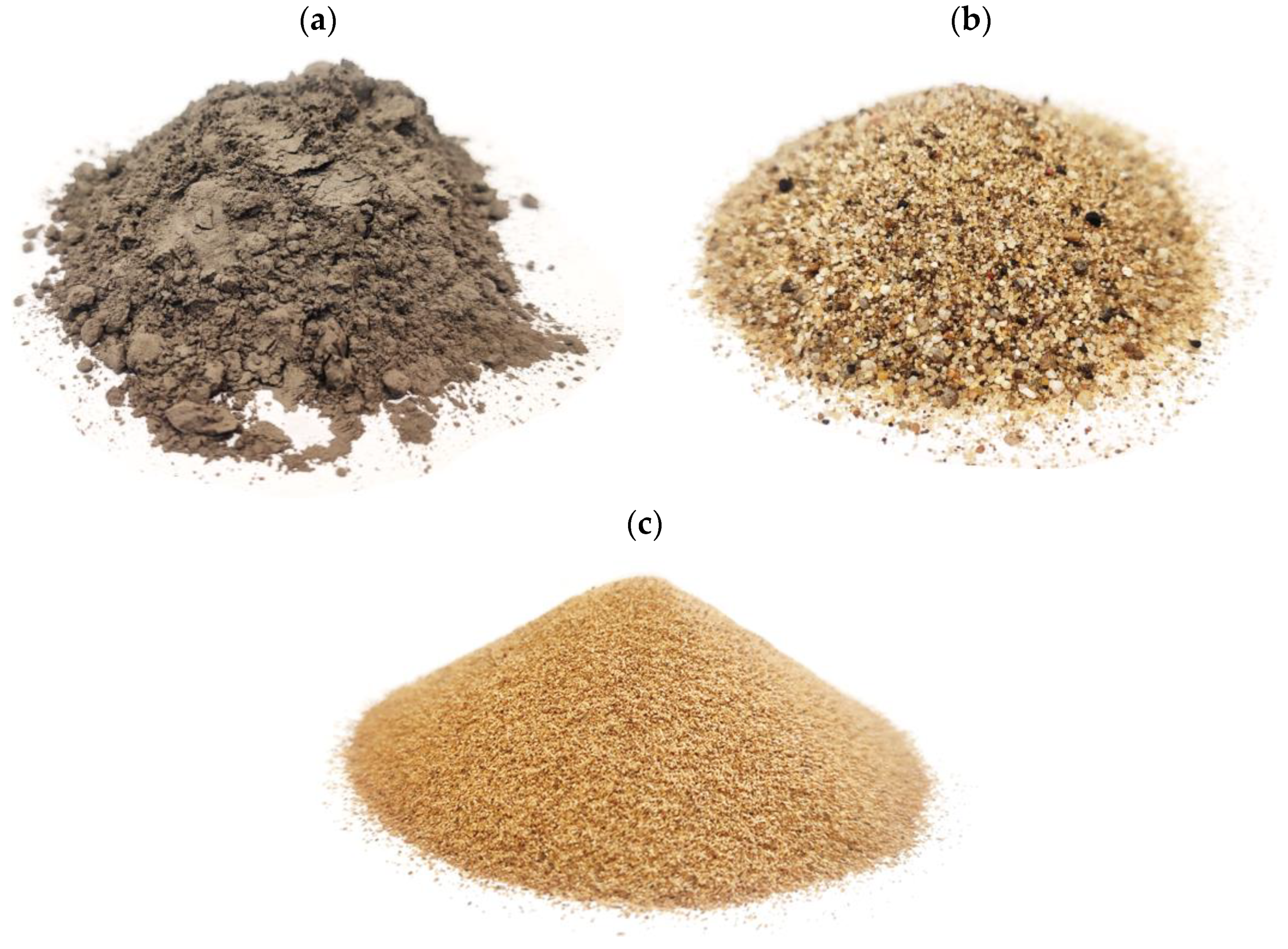
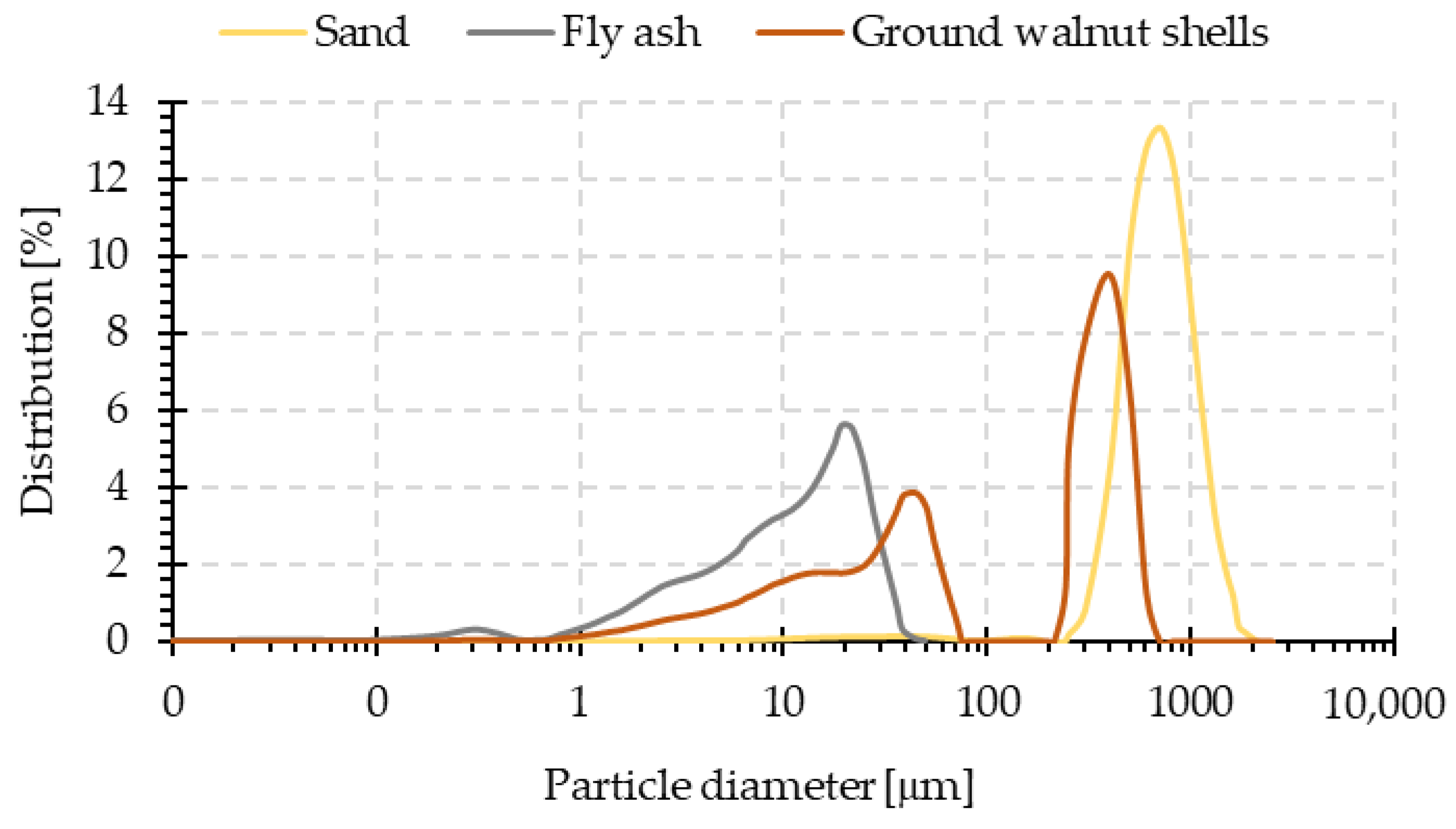
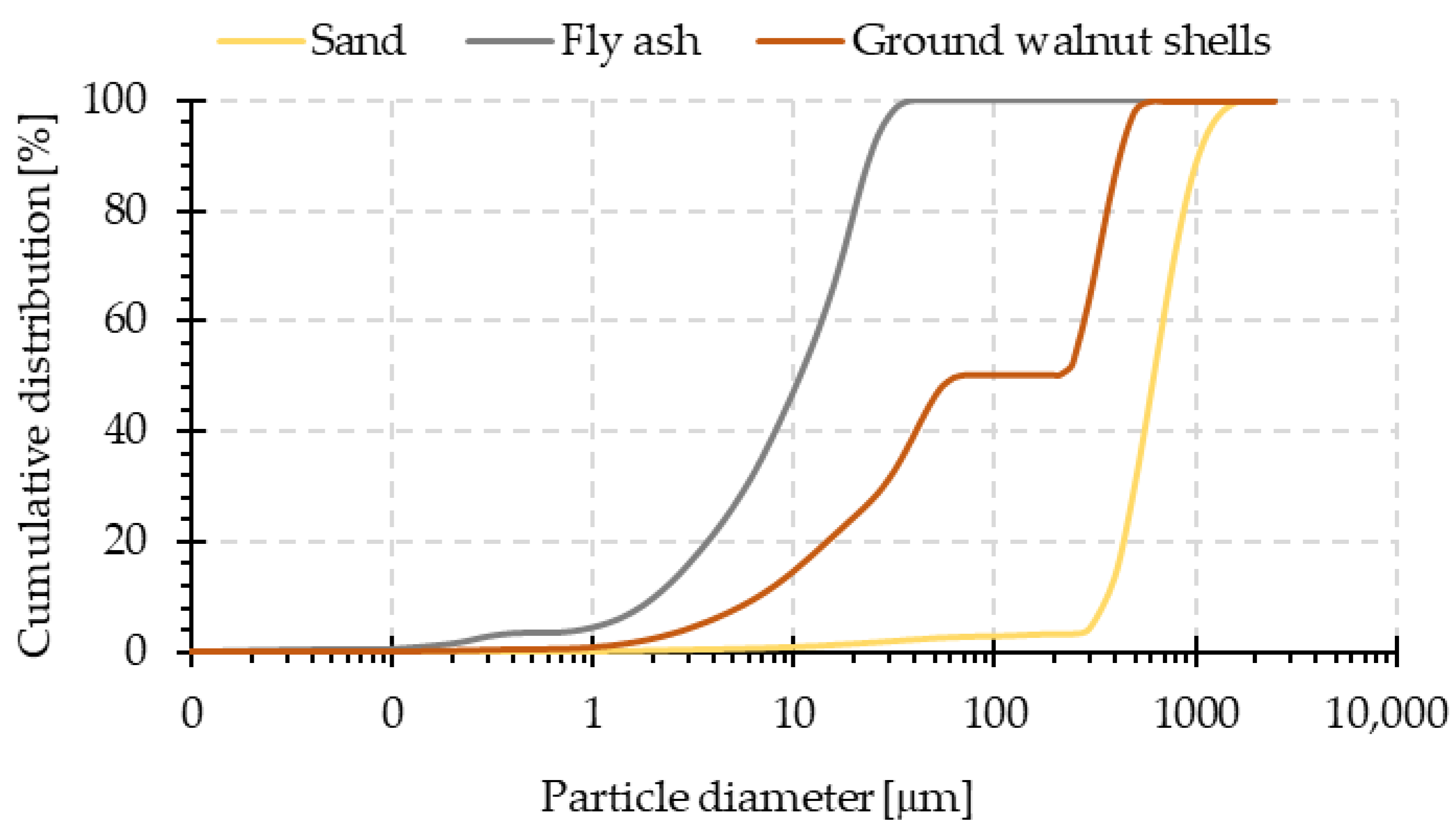

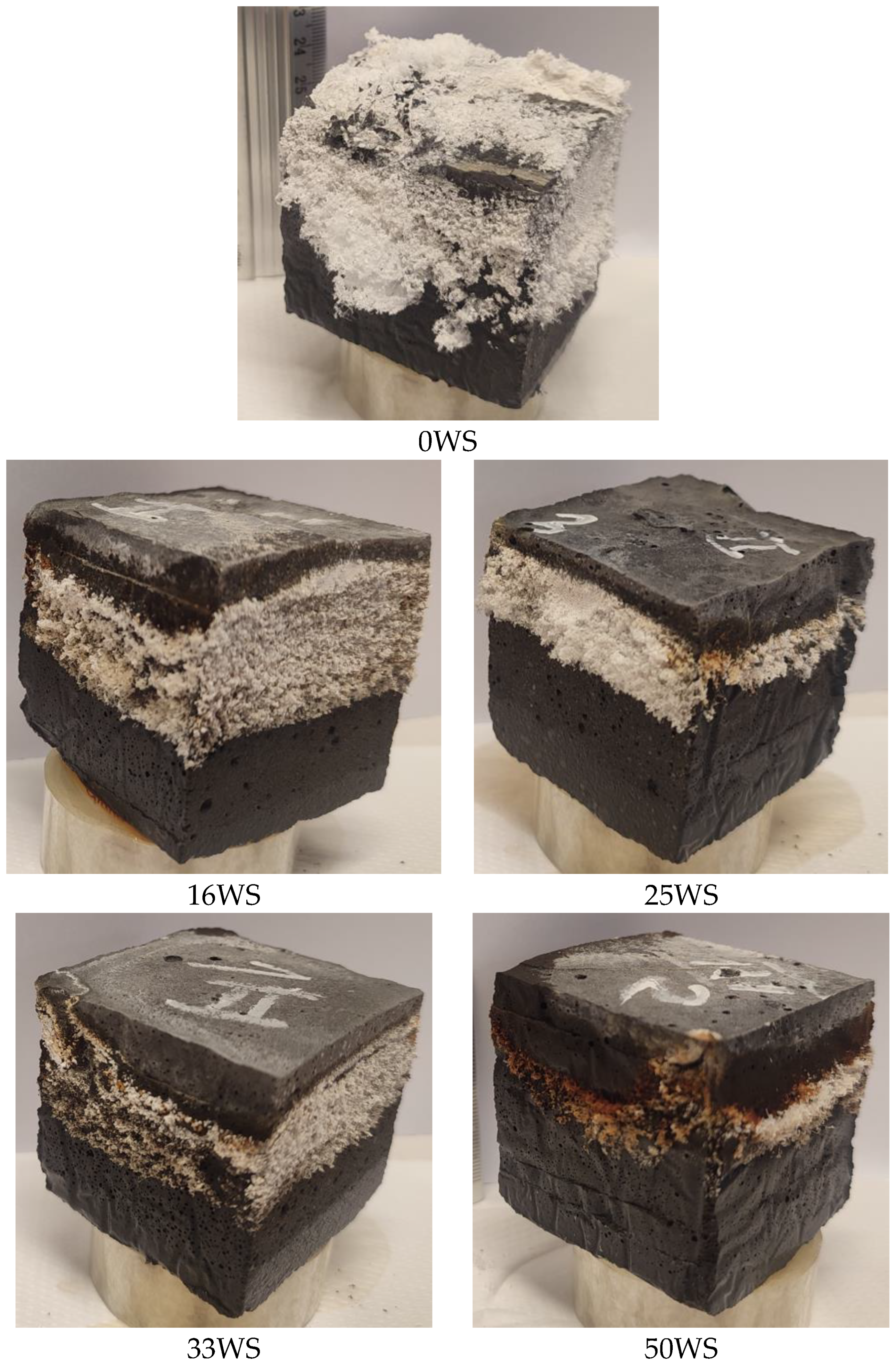
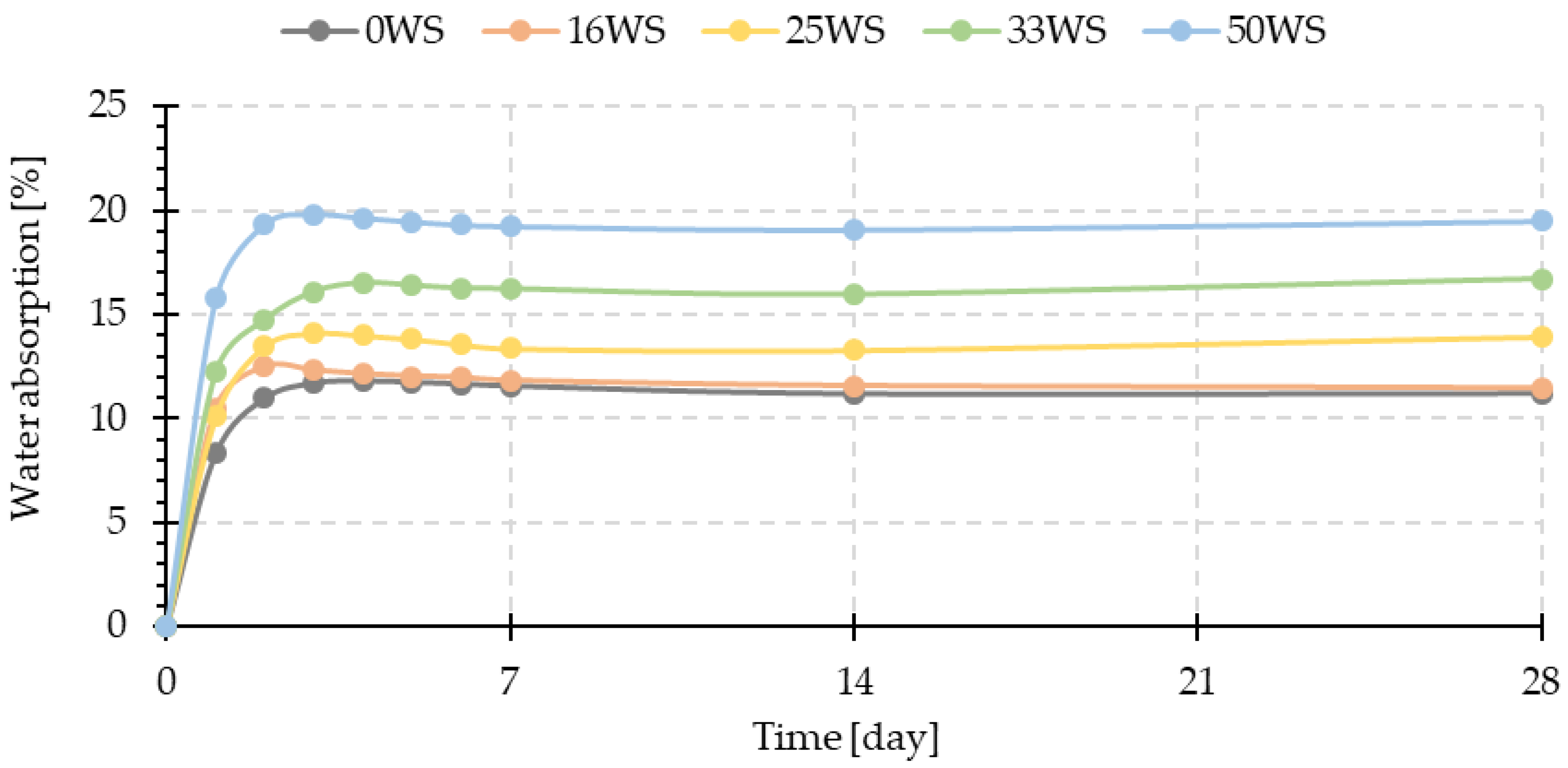

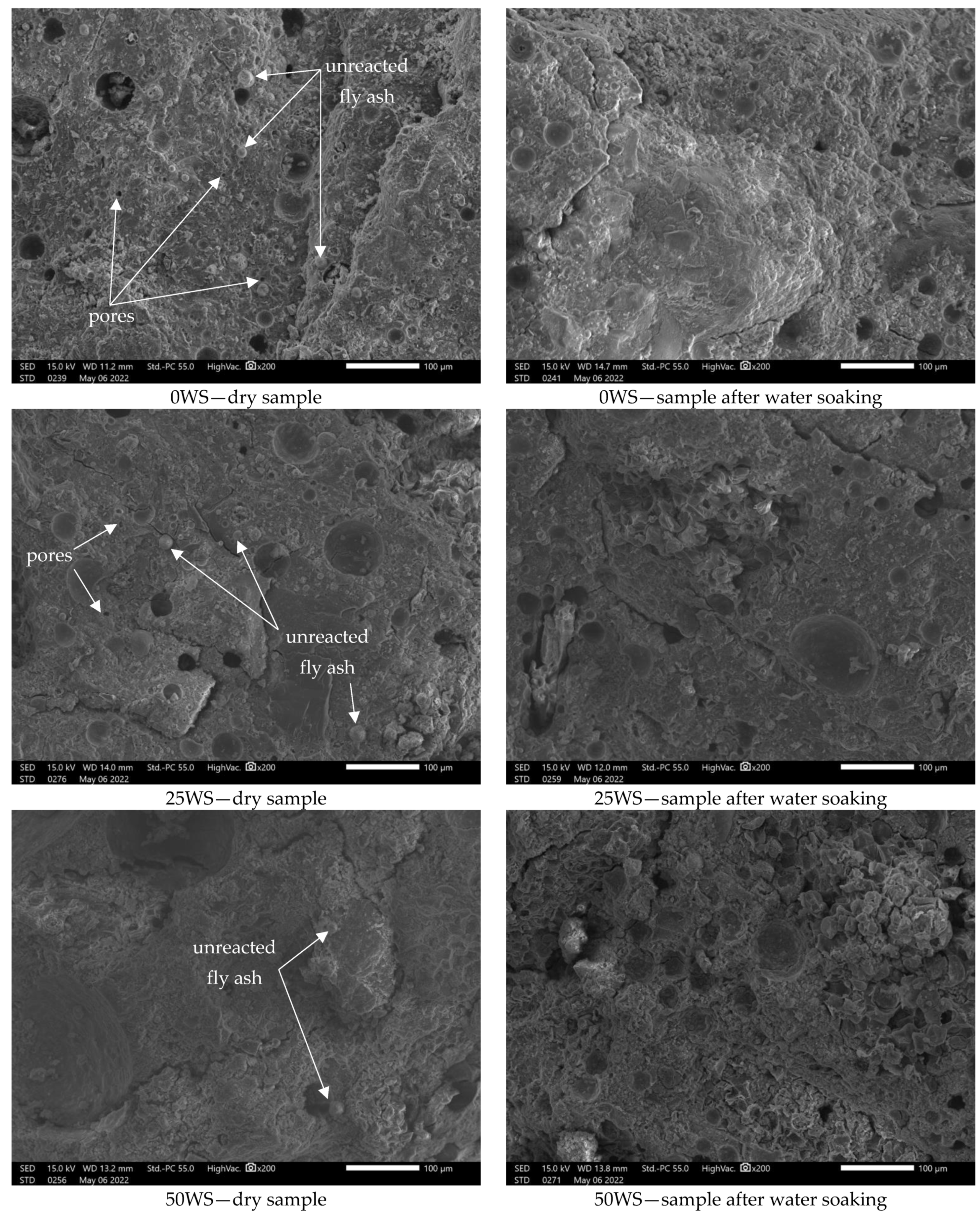
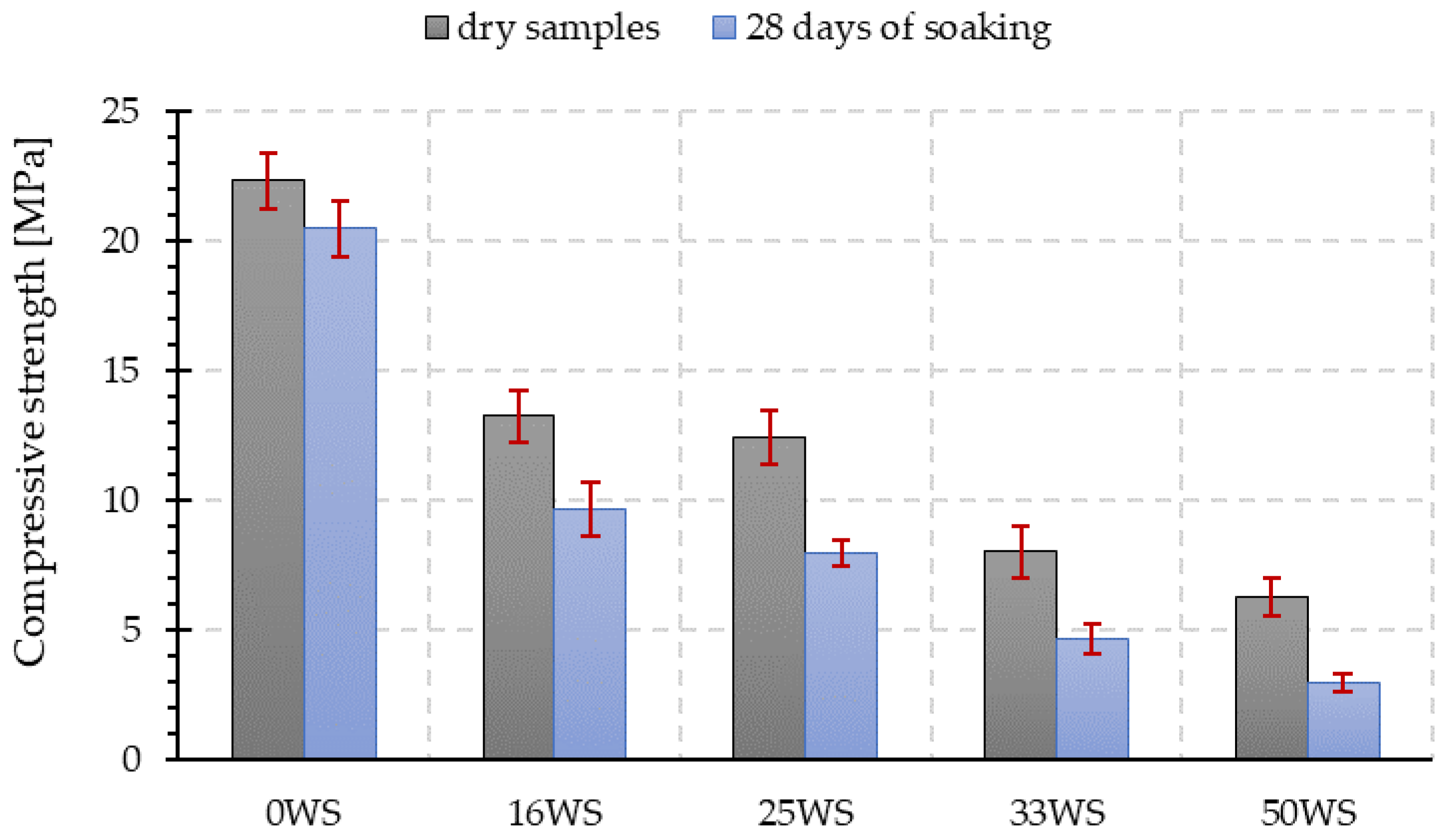
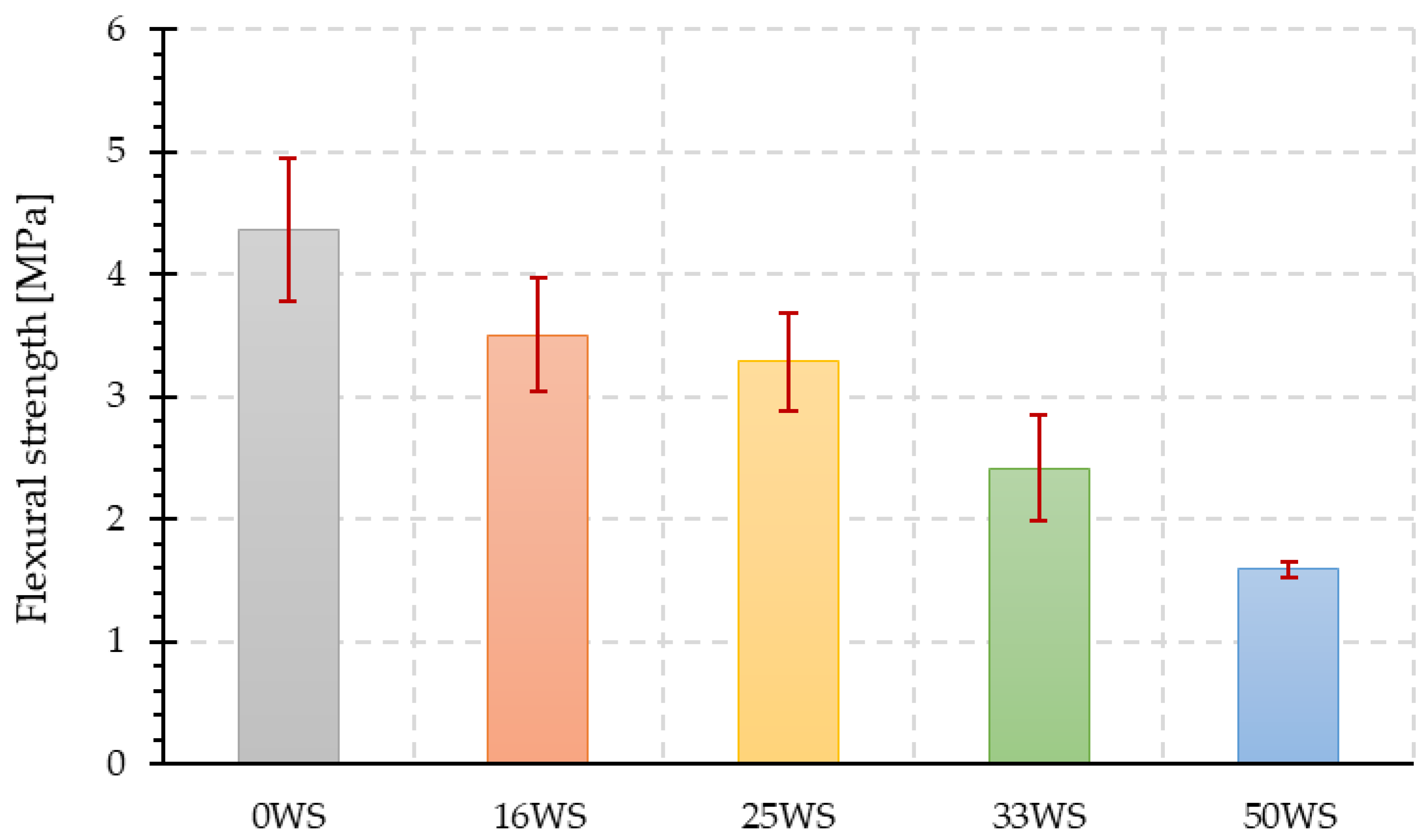
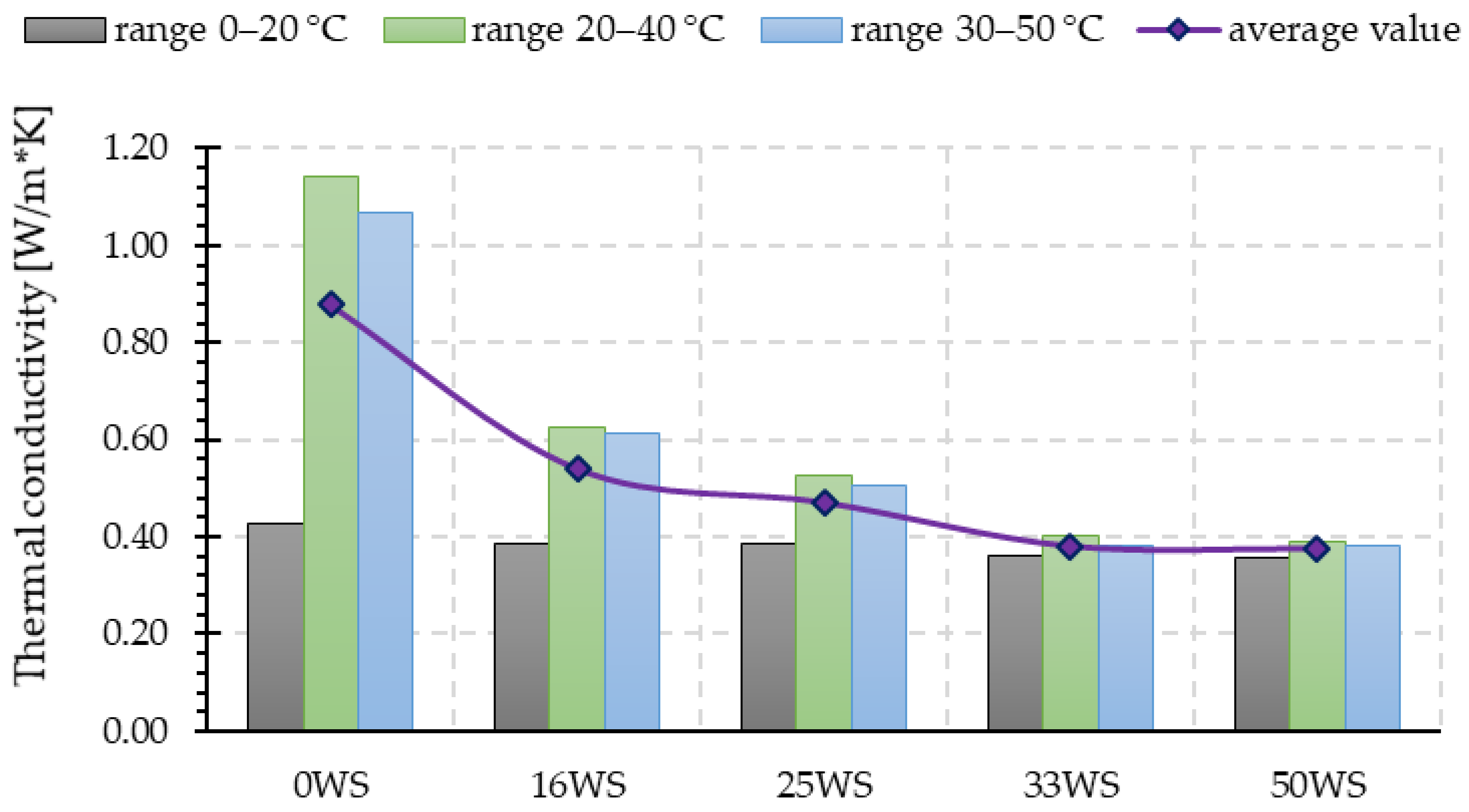
| Sample ID | The Proportion of Solid Components (% by Weight/by Volume) | ||
|---|---|---|---|
| Fly Ash | Sand | Ground Walnut Shells | |
| 0WS | 50/36.6 | 50/63.4 | - |
| 16WS | 50/43.7 | 33.33/37.9 | 16.67/18.5 |
| 25WS | 50/46.7 | 25/27.0 | 25/26.4 |
| 33WS | 50/41.0 | 16.67/47.4 | 33.33/11.6 |
| 50WS | 50/54.1 | - | 50/45.9 |
Publisher’s Note: MDPI stays neutral with regard to jurisdictional claims in published maps and institutional affiliations. |
© 2022 by the authors. Licensee MDPI, Basel, Switzerland. This article is an open access article distributed under the terms and conditions of the Creative Commons Attribution (CC BY) license (https://creativecommons.org/licenses/by/4.0/).
Share and Cite
Kozub, B.; Castro-Gomes, J. An Investigation of the Ground Walnut Shells’ Addition Effect on the Properties of the Fly Ash-Based Geopolymer. Materials 2022, 15, 3936. https://doi.org/10.3390/ma15113936
Kozub B, Castro-Gomes J. An Investigation of the Ground Walnut Shells’ Addition Effect on the Properties of the Fly Ash-Based Geopolymer. Materials. 2022; 15(11):3936. https://doi.org/10.3390/ma15113936
Chicago/Turabian StyleKozub, Barbara, and João Castro-Gomes. 2022. "An Investigation of the Ground Walnut Shells’ Addition Effect on the Properties of the Fly Ash-Based Geopolymer" Materials 15, no. 11: 3936. https://doi.org/10.3390/ma15113936






